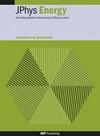Engineered charge transport layers for improving indoor perovskite photovoltaic performance
IF 6.3
3区 材料科学
Q1 ENERGY & FUELS
引用次数: 0
Abstract
The developing Internet of Things market is attracting the indoor photovoltaic (IPV) as an essential power source. Perovskite photovoltaics (PPVs) are a fascinating candidate for IPV in solution-processable photovoltaics. Recent developments in PPVs can deliver power conversion efficiency (PCE) up to 25% outdoor (AM 1.5 G) and over 40% under indoor (1000 lux) light. The selection of charge transport layers (CTLs) has played an essential role in improving PPVs indoor performance. Herein, formamidinium-caesium-based mixed-cation (FACsPb(I,Br)3) PPV devices are fabricated, and evaluated their outdoor and indoor performances by changing the different CTL combinations such as PTAA-PCBM and SAM-C60. Outdoor PCEs were 13.76% and 15.27% achieved for PTAA-PCBM and SAM-C60-based devices, respectively. Meanwhile, under LED (4000 K) 1000 lux, the PCEs were 26.32% and 31.92% for PTAA-PCBM and SAM-C60-based PPV, respectively. The short circuit current (改善室内过氧化物光伏性能的工程电荷传输层
不断发展的物联网市场正吸引着室内光伏(IPV)成为必不可少的电源。在可溶液加工光伏技术中,包晶光伏(PPV)是 IPV 的理想候选材料。最近开发的 PPV 在室外(AM 1.5 G)的功率转换效率(PCE)可达 25%,在室内(1000 勒克斯)光照下可超过 40%。电荷传输层(CTL)的选择对提高 PPV 的室内性能起着至关重要的作用。本文制作了甲脒铯基混合阳离子(FACsPb(I,Br)3)PPV 器件,并通过改变不同的 CTL 组合(如 PTAA-PCBM 和 SAM-C60)评估了其室外和室内性能。基于 PTAA-PCBM 和 SAM-C60 的器件的室外 PCE 分别为 13.76% 和 15.27%。同时,在 LED(4000 K)1000 勒克斯条件下,基于 PTAA-PCBM 和 SAM-C60 的 PPV 的 PCE 分别为 26.32% 和 31.92%。短路电流(Jsc)(116.8-122.5 µA cm-2)和填充因子(FF)(0.724-0.817)是基于 SAM-C60 的器件在室内光照条件下改善的主要参数。这项研究指出了 CTL 组合的重要性,并表明了 SAM-C60 夹层在 PPV 室内应用中的巨大潜力。
本文章由计算机程序翻译,如有差异,请以英文原文为准。
求助全文
约1分钟内获得全文
求助全文
来源期刊

Journal of Physics-Energy
Multiple-
CiteScore
10.90
自引率
1.40%
发文量
58
期刊介绍:
The Journal of Physics-Energy is an interdisciplinary and fully open-access publication dedicated to setting the agenda for the identification and dissemination of the most exciting and significant advancements in all realms of energy-related research. Committed to the principles of open science, JPhys Energy is designed to maximize the exchange of knowledge between both established and emerging communities, thereby fostering a collaborative and inclusive environment for the advancement of energy research.
 求助内容:
求助内容: 应助结果提醒方式:
应助结果提醒方式:


